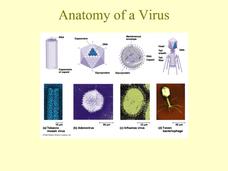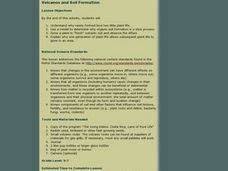Curated OER
What happens to water before we use it?
Students examine how water is treated prior to becoming available for human consumption. In this water treatment lesson, students conduct an experiment in which they filter water. Students formulate a hypothesis, test, analyze data, and...
Curated OER
Sense and Sensibility by Jane Austen
In this online interactive reading comprehension worksheet, students respond to 15 multiple choice questions based on Sense and Sensibility. Students may submit their answers to be scored.
Curated OER
Anatomy of a Virus
This PowerPoint summarizes details about the virus from the structure and reproduction methods to the different modes of infection. Various viral diseases of animals and plants, viroids, prions and genetic origins of viruses are discussed.
Curated OER
Marine Protected Areas (MPA)
Ninth graders explain the purpose of MPA's. In this biology lesson plan, 9th graders identify MPA's in Southern California. They simulate coastal sampling using candy from two buckets. Students analyze their results and share it with the...
Curated OER
Food Safety Unit Exam 1
Students complete seventeen question test about food safety which includes matching vocabulary terms, short answer questions and fill in the blank questions. Test is part of the Food Safety Unit produced by the College of Agricultural...
Curated OER
Forest Management ~ Diseases and Pests that Effect a Good Harvest Stand
The forestry presentation found here lists and describes a variety of tree diseases. A few unappetizing photos are included to show symptoms of some of these diseases, or the insects and fungi that cause them. If you have a class that is...
Curated OER
Fungus Among Us- Non-Fiction Reading Comprehension Worksheet
In this fungus non-fiction reading comprehension worksheet, learners read a 3 page selection that describes the characteristics and life of fungi. They answer 10 questions based on the reading which include true or false, multiple...
Curated OER
Ocean Exploration: Dentists of the Sea!
Students watch videos about unusual fish behavior and write to marine scientists about the proper care of fish. In this fish lesson plan, students watch the videos on how to properly transfer fish to saltwater, and they do so in an...
Curated OER
Body by Design: Form and Function
Students study symbiosis and its association in nature. In this organisms lesson students divide into groups and research organisms that have a symbiotic relationship.
Curated OER
I Wash My Hands of It!
Young scholars conduct a survey about hand washing. They view the results and examine "Infection Charts". They research diseases and talk about the importance of handwashing and how they could improve their hand washing habits.
Curated OER
Population Dynamics
Students discover how organisms are dependent on one another for survivial. They also discuss how to conserve natural resources. They compare and contrast the different types of symbiotic relationships as well.
Curated OER
Life Cycle Literature Briefs
Literature containing life cycle information is available from many sources. Several examples of this type of literature are listed below with a synopsis and sample questions for each. These examples have been taken from a variety of...
Curated OER
Working With Environmental Issues
Students begin the instructional activity by completing a survey about how much and what types of water they drink on a daily basis. Using a worksheet, they calculate the amount of water an American uses each day and the amount their own...
Curated OER
Sponges, Cnidarians, Flatworms, and Roundworms
In this simple animals worksheet, high schoolers compare and contrast the body plans of sponges, cnidarians, flatworms, and roundworms. This worksheet has 4 short answer questions.
Curated OER
Epidemic, Plague, and Infection
Students investigate the illness borne in concentration camps. In this Holocaust lesson, students participate in a simulation that requires them to consider how ailments became epidemics in concentration camps.
Curated OER
Specialized Structures and Environment
Fifth graders read about how different animals protect themselves, and how characteristics give animals an advantage in their environment. Students then discuss a variety of "outer" wear for humans, and what they might choose to wear in...
Curated OER
Food Web Relationships
For this food web worksheet, students create a food web matrix and answer short answer questions about the food chain according to the matrix. Students complete 7 short answer questions.
Curated OER
The Three Worm Phyla
Ninth graders examine the three worm phyla. For this classification lesson, 9th graders observe, compare and contrast the planarian, tapeworm, and fluke.
Curated OER
Studying a Piece of an Ecosystem
Students carry out an outdoor land study in which they identify organisms living in the soil, and any other animals living within the site. Groups also examine abiotic factors. They respond to a series of questions concerning their data...
Curated OER
Taxonomy Project
Students act as a taxonomist and, given a certain situation, classify existing organisms.
Curated OER
Why So Many Frogs?
Young scholars explain the different stages in the growth of a frog, then analyze and collect data to make generalizations about a larger population. They determine the survival rate of a population of tadpoles under controlled conditions.
Curated OER
Create a Non-native/Invasion Species
Students view a video about non-native/invasion species. They create a non-native/invasion species that they think would have an impact on farming, industry, recreation, or water in the local environment.
Curated OER
Household Pests
Students participate in an experiment to show how germs are spread, by food, fingers and feces. They conduct a bacteria count using a colony counter.
Curated OER
Habitats and Functions
Students use a large seet of habitat cards, spread out in one area. They, in groups, practice sorting themselves into the correct habitat based on what function card they received.
Other popular searches
- Parasites in Taiga
- Taiga Parasites
- Animal Parasites
- Types of Parasites
- Human Parasites
- Parasites Science
- Veterinary Parasites
- Parasites Bacteria
- Life Cycle of Parasites
- Bacteria Viruses Parasites
- Hosts and Parasites
- Parasites and Agriculture

























